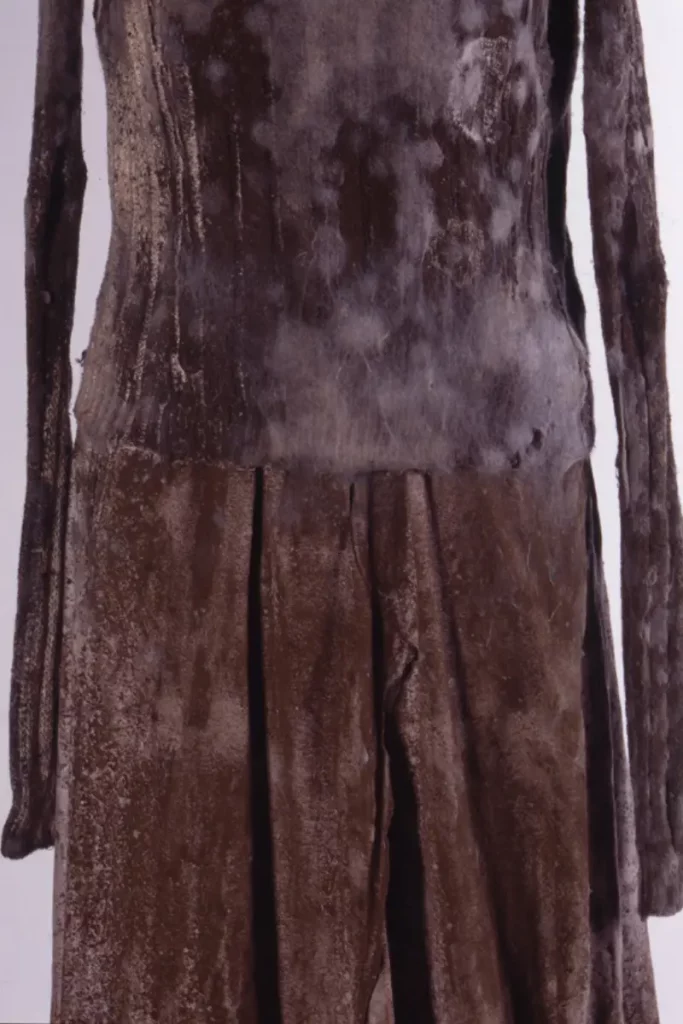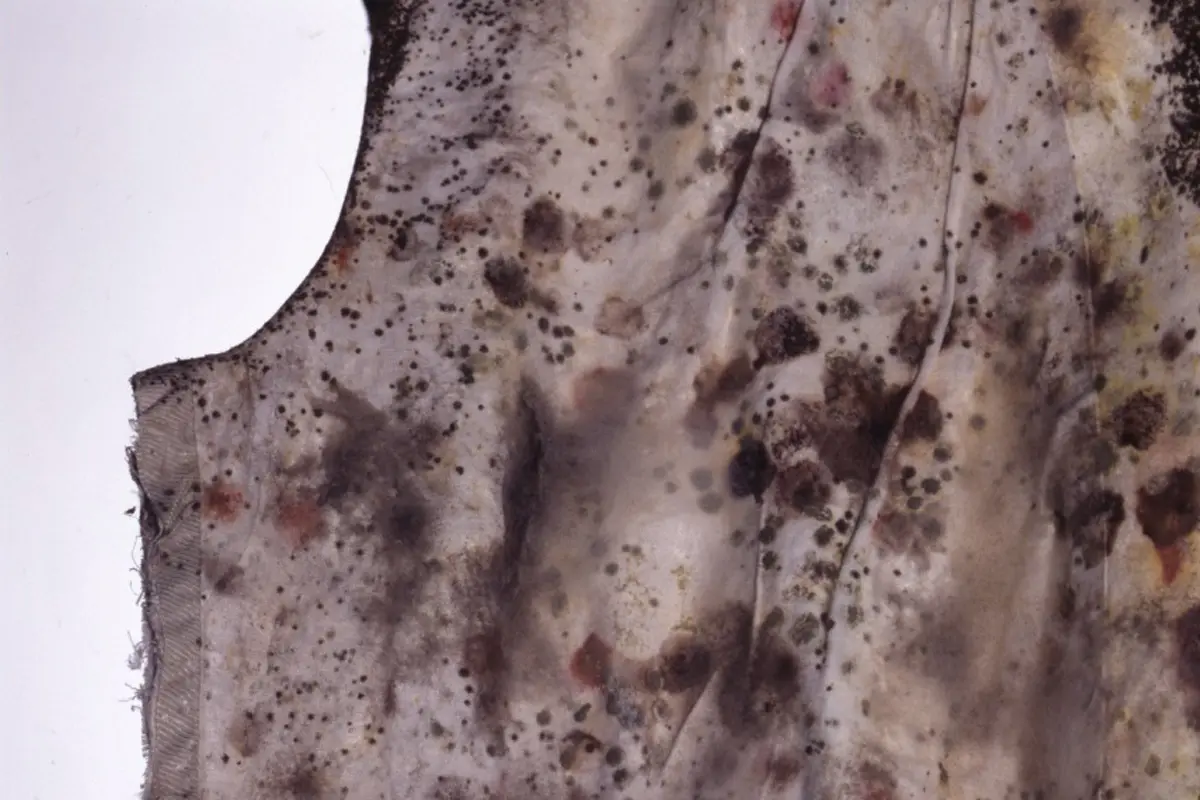Who remembers Martin Margiela’s bacterial stunt from 1997? Mold on clothes, multiplied in the backyards of contemporary museums. Retracing the technique used in the exhibition
Runway season had become monotonous. On the last night of Couture Week, spring 2024, John Galliano brought it all back: conceptual, unprecedented, unwearable garments. Similar to Martin Margiela’s overlooked experiment in the year of outspoken fashion revolts, 1997: mold covered clothes.
Textile fibers. Margiela’s mold covered clothes – recollections from curator Thimo te Duits
La Maison Martin Margiela wanted to execute its experiment in Museum Boijmans Van Beuningen. The Dutch Museum agreed and proposed a collaboration with an architect, which the house declined. Instead, curator Thimo te Duits arranged a collaboration with Wageningen University, known for its freshmen moldy tea towels experiment.
La Maison Margiela wanted to join in, aiming for clothes that turn green, «similar to how bacteria affect garden sculptures» , adds Te Duits. Margiela developed the technique with a microbiologist from the university, Dr. Ad Van Egeraat, who was at the end of his science career: the cloth went into a soup called agar – a nutrient medium. This mixture of nutrients, salts, and building blocks allows bacteria to grow and it can be applied as a transparent layer on textiles.
Margiela’s 97 project – a connection to Antoni van Leeuwenhoek
Mr. Margiela placed those agar-dipped looks on mannequins, upon which he misted mold, bacteria, and yeast with a plant sprayer. The preparation process took place seven days before the exhibition, in small greenhouses in the museum’s garden the audience knew nothing about. Over the course of the exhibition, the forethought mixture started to live its own life, blooming over the fabrics – mold covered clothes.
Looks on display were replicas from Margiela collections between spring 89 and fall 97, executed in the same cotton and denim fabrics in white shades. Viewed from within the pavilion, the exhibition extended into the garden. Te Duits: «The opening was special. A thousand people showed up, but once inside, there was nothing to see. Then the blinds went up – and there were 18 moldy sets waving outside amid the storm». From one day to the next, the beige and basic tops and bottoms acquired a rich, downy appearance in subdued burgundy, ocher, and moss green.
With Margiela’s 97 project, he seeks a connection to Antoni van Leeuwenhoek, the Dutchman immortalized for his “small see-er.” The 17th-century cloth merchant discovered the vast realm of tiny microbes living on his ribbons and linens. Because that thread was still worth something in the Golden Age, Van Leeuwenhoek wanted to know the quality of the products he sold to seamstresses and tailors. A magnifying glass unveiled how the fibers were imbued with living organisms.
Containers filled with mold for Tokyo and New York – textile fibers
A condition of the house in collaboration with Boijmans was that the exhibition would travel to New York and Japan. Te Duits succeeded. In April 1999, the exhibition was executed in the same way in a young Museum of Contemporary Art Tokyo and in May in the Brooklyn Bridge Anchorage, the vaults at the base of the iconic bridge. The three white or beige sets and the mold were sent independently to replicate the experience on-site. In New York, Te Duits recalls that the impact on the fabric was somewhat less intense.
At the end of the Brooklyn exhibition, Margiela’s spokesman Patrick Scallon told the New York Times «They are in such an advanced stage of decomposition that they can never be worn». Boijmans’ administrative assistant, who remains seated after forty years of duty but doesn’t want to be named, spoke similar words before. It was self-explanatory that the pieces would be destroyed: «Keeping them was never an option, or the entire depot would have turned moldy».
The experiment suited the time, when shows were held in unusual locations, and questions were raised about how fashion should be presented in a museum context. Te Duits, who left the industry and is not likely to return, considers it a contemporary topic as well. «Fashion exhibitions are without exception presentations on mannequins in an environment designed by stylists, as if it were theater. I always wanted to escape this white cube principle when I worked with fashion in a museum context».

Analysis of a microbiologist: Kas Houthuijs on Margiela’s mold covered clothes
Mr. Margiela’s approach to fashionable mold is common in microbiological research, says lecturer ecological art & design Kas Houthuijs. «These bacteria are single-celled organisms, and they live on the material. Depending on the type, they can produce dye and even excrete it. The excretion of a dye causes the area on the fabric where they grow to become colored».
Margiela introduced bacteria directly onto the textile, but you can also allow bacteria from the air or skin to grow on a culture medium, endowing a fingerprint of the place or person. The air around us contains dust particles, pollen, and water droplets, all of which contain bacteria. Similarly, our skin is completely covered with our own personal bacteria – our microbiome.
This society of microorganisms is everywhere in and on our bodies
«This society of microorganisms is everywhere in and on our bodies. They produce vitamins, protect us from disease, and break down food so that we can absorb the nutrients. They determine a state of mind: whether we are happy or sad. Microorganisms make up half our body cells. Without them we would be sick and unaware who we really are».
Houthuijs explains why Margiela’s coloration experiment didn’t have any commercial value: «The bacteria on the fabric changed color. When nutrients are depleted, the bacteria or fungus will slowly dwindle and die, causing color changes. Washing the clothing will remove a portion of the bacteria and, consequently, the color». Besides, obtaining one specific type of microorganism is challenging when you’re not working in a sterile environment, as with the Margiela 97 project.
Growing bacteria as a dye factory – textile fibers
Mr. Margiela’s project wouldn’t have been possible without the help of a microbiologist. Soon the same might hold true for apparel and luxury brands that need scalable, sustainable dyeing alternatives. Wet dyeing processes used to color textiles make up over half of all greenhouse gas emissions in the supply chain, according to a report from the Apparel Impact Institute (Aii) and World Resources Institute (WRI).
Like Mr. Margiela, artists and designers are developing coloration methods using bacteria and fungi – single-celled organisms. «They collaborate with the bacteria, rather than just applying them on textiles», explains Houthuijs. «The bacteria excrete a dye that becomes part of the fabric, allowing for precise and localized color application. There is symbiosis between the designer and the bacteria in shaping a pattern».
Bacteria – pervasive forms of microbial manufacturing
Houthuijs follows the work of artists and researchers that develop creative biomaterial solutions or evoke meaningful contemplations, such as Paul Vanouse’s “Labor”. The project reflects upon industrial society’s shift from human and machine labor to increasingly pervasive forms of microbial manufacturing. «He collected bacteria from the skin of sweating humans, then cultured them to apply them onto a clean white shirt. The shirt looked and smelled like hard work, but the only ones that labored in the process were those bacteria». The dynamic, self-regulating art installation reminds of a fashion utopia, in which sweatshops forgo without human effort.
Closer to commercial applications are designers Ilfa Siebenhaar and Laura Luchtman, who experimented with pigment-producing bacteria in collaboration with brands such as Puma. It requires little water, low temperatures, and no textile treatments. Colors are vibrant and hold their longevity, challenging industry standards. Eventually, bacteria will become dye factories, posing an alternative to toxic textile dyes.
Maison Margiela
Maison Margiela was founded by Martin Margiela, a Belgian fashion designer, in 1988. Renowned for his deconstructivism approach and wish to remain anonymous – visualized by the numerical labels attached with dressmakers’ basting stitches – the house challenges conventional norms. Margiela blurred the lines between art and fashion, putting innovative materials and silhouettes at the center. His conceptual designs often feature repurposed materials and exposed seams. Iconic are the Tabi boot and the use of unexpected, reclaimed objects. Since 2014, John Galliano has served at the post as creative director of the house.



















